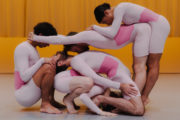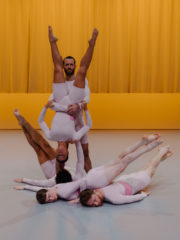“The errand into the maze,
Emblem, the heel’s blow upon space,
Speak of the need and order the dancer’s will.
But the dance is still.”
DANCE PIECE, Ben Belitt
I’ve read an interview on Spike, between artist Uri Aran and choreographer Adam Linder, and this came up, “how to do things not badly, but well.” In a world where performance as performativity is being mostly capitalized, I needed, without even knowing it, to read about making it by making it well. Linder’s way of expressing things is as necessary as his approach to conventions. Shifting, updating, hybridizing.
Though future is a constant point of view, the past is never unlooked at.
For Linder, former dancer, turned choreographer, physicality is both a language, and a time. Moods are being manipulated in time and by time, as we’re allowed either to stay or leave.
‘(THINGS) DO NOT ALWAYS GO WHERE ONE MIGHT EXPECT, BUT RATHER UNFOLD’.
There’s this vocabulary of small crafts, and of loyalty – to one’s self, to one’s vocation, to tradition, as much as to breaking everything into pieces, now and then, for new purposes and possibilities. Linder’s moving universe exists within a humble and intimate dimension, blessedly concatenated with the mellow, aged, constantly practiced, immediate and unaffected style.
“Loyalty is the result of a thinking-process, about what the form of ballet can be today. I was trained as a ballet dancer, but I have not worked with the form in a long time, ever since I left the Royal Ballet. I think I was 21 at that time, and trying to figure out how could form be reinvented so that it would be relevant again today.”
– Adam Linder, about Loyalty, a ballet in three acts set to the music of the British avantgarde band Coil, co-produced by Kampnagel (Hamburg), in 2021.
Liza Weber, of Tanzschreiber, writes about “a sterile smell of a hospital ward and wonder: is ballet on its last legs?”. Linder replies, “maybe in some way I’m kind of operating on ballet, like there’s me going back into ballet and renovating and operating on it. I would say there is a kind of treatment happening to ballet. It’s not dying, it’s resurrected.”
Loyal to preservation, at the same time, loyal to restoration. Loyalty is all about the process, it involves both past, and future, ruins, and new formations. Loyalty is about virtuosic dedication. Loyalty is about practice and consistent unabandon. To go forward, we need to acknowledge how far we’ve come.
FETISHIZING THE PHYSICAL QUALITIES OF FORM
“If you can bring all the social qualities of today, let’s say, group dynamics, polysexuality, self-reflexivity, if you can bring that to ballet, it’s such an amazing, weighted counterpoint to understand progress.”
There’s the physicality of surfaces, and grounding as a practice, as a mission. Linder’s Loyalty is about grounding the ballet into the now, while forging a blended physicality that is both raw and refined, simultaneously embracing darkness and light, and forecasting embodiments of both animal and human.
After all, Loyalty is nothing but a love letter to ballet, so how do you translate that into smell since that’s our language of physicality and devotion? Audience as participator, myself as participator. If I’d have to think of dance as of a perfume, what if the one wearing a fragrance is nothing but the fragrance’s audient, the participator. By choosing a fragrance, don’t we choose a performance, a vocabulary as physical as a choreographed dance? Isn’t a nose a choreographer of smells, after all?
NOWNESS WITH INSERTIONS OF PAST
FOLIE: What are some of your early memories involving scent?
ADAM: I have a very strong sense of smell and it is very evocative to me. I grew up in Sydney, next to a park, and since Sydney is very humid, there’s this smell of soil and a particular smell of plants developing.
I spent a lot of time with my grandmother when I was young. She used some old-school wooden toothpicks, that had a very particular smell, of menthol. She would disinfect our hands with this classic old German cologne, Echt Kölnisch Wasser by 4711.
F: What’s your relationship with fragrances and perfume?sky?
A: I don’t wear perfume all that much. It is a bit like Yoga to me, I love it, but I don’t always practice it. But I do like funky smells, as well as spicy woody scents. I do have a perfume I’m loyal to, an old Dior fragrance, called Patchouli Imperial. I like the old Dior fragrances, the classics, the musky ones. And I have always loved the smell of figs. I love fig trees, and I love fig as a fruit.
F: The Loyalty fragrance – risky or not risky?
A: It is risky, but you trust it. It’s not risky just for the sake of being experimental. It’s risky because you have the option to stay or leave, to wear it or not.
F: What are some of the things that are essential to your fulfillment?
A: A sense of adventure and the earthly pleasures – music, dance, sex, and food. My friends, my people, my family.
F: How would you describe the 3 acts of Loyalty?
A: The 1st act is a parade of different vocabularies. It uses and abuses ballet. It is monochromatic, and strict. The dancers wear black in a very graphic manner. It is very technical and virtuosic. Like a well-oiled machine.


Photo: Diana Pfammatter
The 2nd act is theatrical. A naked solo figure doing a kind of crude physicality. It is fleshy, earthy, a bit gritty, and brutal. Like left over crumbs on a plate.

The 3rd act is a polyamory of partnering. It is luscious, warm, with beautiful pinks and oranges and reds. It is sensual, tactile, and voluptuous.

Photo: Diana Pfammatter
F: What was going on in your life when you conceptualized the show?
A: The process spread over time, as I was transitioning between locations. I spent a lot of time in LA, where I was in fact living. As I started sketching Loyalty, we moved to an apartment in this very famous building called El Royale. El Royale is a late 1920’s famous landmark in LA. A tall fusion style apartment building located in the Hancock Park neighborhood, that used to be a hotel. A lot of celebrities lived there. It had a beautiful panoramic view over Los Angeles. I spent a lot of time in that apartment thinking about Loyalty. Then, as I started working on the piece, I was already back in Europe. I crafted the whole play in Hamburg. It was summer and I was happy, the return to Europe felt like coming home after nearly 6 years spent in the US. I was working very intuitively. It felt like a new beginning.
F: How do you expect the audience to feel during or after the performance?
A: I want them to be engrossed, I want my work to consume or engulf the audience. I want them to think that’s the best thing they’ve ever seen.
_
Concept & Choreography: Adam Linder / Created and danced with: Douglas Letheren, Joshua Harriette, Louella May Hogan, Paxton Ricketts, Stephanie Amurao / Stage & lighting design: Shahryar Nashat / Costume design: Adam Linder / Music: Coil / Music arrangement: Steffen Martin / Artistic assistance: Cooper Jacoby / Artistic advice: Justin Kennedy, Emma McCormick-Goodhart / Choreography assistance: Anand Dhanakoti / Programme design: HiT Studio / Technical direction: Jan Havers / Light technology: Boris Heiland / Production & tour management: Uta Engel / Company management & international relations: Andrea Niederbuchner



